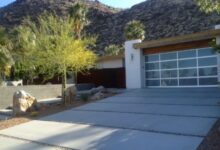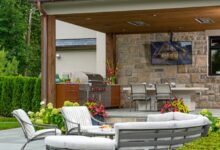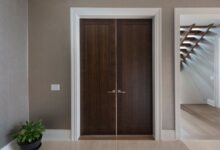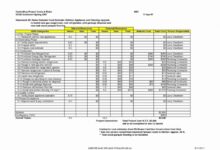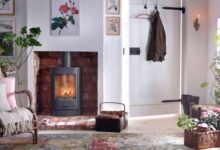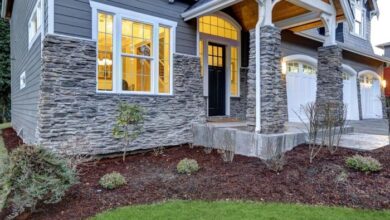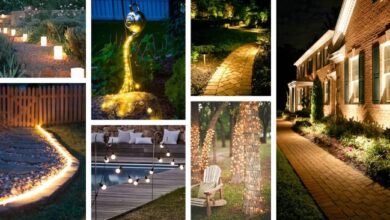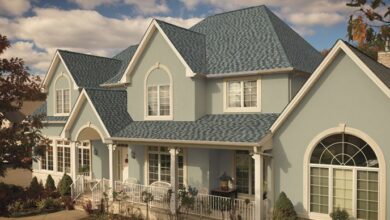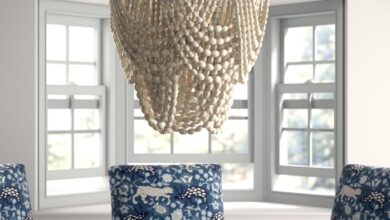Modern Home Exterior Design Ideas
Modern home exterior design ideas offer a captivating blend of form and function, pushing the boundaries of traditional aesthetics. This exploration delves into the diverse styles, materials, color palettes, and landscaping options that define the modern home exterior, guiding you through the process of creating a visually stunning and highly functional living space. From minimalist designs to the incorporation of sustainable materials, we’ll uncover the key elements that contribute to a truly exceptional modern home facade.
We will examine popular modern styles like minimalist, contemporary farmhouse, mid-century modern, Scandinavian, and industrial, comparing their distinctive characteristics and material choices. The role of color palettes, finishes, and textures in shaping the overall aesthetic will be thoroughly discussed, along with the importance of landscaping and outdoor features in creating a harmonious and inviting atmosphere. Finally, we’ll explore the impact of windows and doors, crucial elements in defining both the style and energy efficiency of your modern home.
Popular Modern Exterior Styles
Modern home exteriors offer a diverse range of styles, each characterized by unique design elements and material choices. Understanding these distinctions can help homeowners choose the style that best reflects their personal aesthetic and lifestyle. This section will explore some of the most popular modern exterior styles, highlighting their defining features.
Minimalist Modern Home Exteriors
Minimalist modern homes prioritize clean lines, simple forms, and a lack of ornamentation. The emphasis is on functionality and a sense of spaciousness. These homes often feature large windows to maximize natural light, flat roofs, and a neutral color palette. Materials are typically high-quality and understated, such as concrete, steel, glass, and wood, used in a restrained manner.
The overall effect is one of calm elegance and sophisticated simplicity. A common example would be a rectangular structure with a minimal overhang, large expanses of glass, and a muted grey or white exterior.
Contemporary Farmhouse and Mid-Century Modern Material Comparisons
Contemporary farmhouse and mid-century modern styles, while both considered modern, utilize materials in distinct ways. Contemporary farmhouses often incorporate natural materials like wood, stone, and brick, creating a warm and rustic feel. These materials are often left exposed or minimally treated to highlight their natural texture and color. In contrast, mid-century modern homes frequently employ more industrial materials such as concrete, steel, and glass, reflecting a sleek and streamlined aesthetic.
Wood is used, but often in a more refined and polished manner, perhaps as sleek paneling or carefully crafted accents. The use of brick might be seen, but it is often integrated into a more modern design scheme rather than being a dominant feature.
Scandinavian and Industrial Modern Home Exterior Design Elements
Scandinavian and industrial modern styles represent contrasting approaches to modern design. Scandinavian modern exteriors emphasize simplicity, functionality, and a connection with nature. Light-colored wood, often in pale tones, is a prominent material, along with white or light grey siding. Large windows are essential, bringing the outdoors in and maximizing natural light. Landscaping often integrates natural elements like evergreens and stone pathways.
Industrial modern homes, conversely, embrace a more raw and utilitarian aesthetic. Exposed brick, metal, and concrete are key materials, often in darker shades. Large windows might be present, but they’re frequently framed by industrial-style metalwork. The landscaping tends to be more minimalist and structured, often featuring hardscaping elements like concrete patios and minimalist planting schemes.
Comparison of Popular Modern Exterior Styles
| Style | Typical Materials | Color Palette | Landscaping Features |
|---|---|---|---|
| Minimalist Modern | Concrete, steel, glass, wood (minimal use) | Neutral tones (white, grey, beige) | Clean lines, minimalist plantings, possibly a gravel garden or simple lawn |
| Contemporary Farmhouse | Wood, stone, brick, metal accents | Warm neutrals (cream, beige, brown), often with pops of darker accent colors | Mature trees, flowerbeds, possibly a vegetable garden, stone walkways |
| Mid-Century Modern | Wood (polished), concrete, glass, steel | Muted tones (grey, greens, yellows), often with pops of bolder colors | Low-maintenance landscaping, often featuring geometric shapes and native plants |
Material Choices for Modern Homes: Modern Home Exterior Design Ideas
The selection of materials significantly impacts the aesthetic appeal, longevity, and environmental footprint of a modern home exterior. Careful consideration of factors like durability, maintenance requirements, cost, and sustainability is crucial for achieving a visually stunning and environmentally responsible design. This section explores the advantages and disadvantages of common materials, provides examples of sustainable design, and compares various siding options.
Wood in Modern Home Exteriors
Wood offers a natural warmth and beauty that complements many modern designs. However, its susceptibility to rot, insect infestation, and weathering necessitates regular maintenance, including staining or sealing. Furthermore, the environmental impact of wood sourcing must be considered, favoring sustainably harvested and certified lumber. The initial cost can be moderate to high, depending on the wood type and finish.
For example, cedar requires less maintenance than pine but is more expensive. Properly treated and maintained, wood can last for decades, adding significant character to a home’s exterior.
Modern home exterior design often emphasizes clean lines and natural materials. Adding a touch of handcrafted artistry can elevate the aesthetic considerably; incorporating unique pieces like those found at Handmade ceramics can bring warmth and character to a minimalist facade. These bespoke ceramic accents, whether used as planters or decorative elements, perfectly complement the modern style, adding a layer of sophisticated detail.
Metal in Modern Home Exteriors
Metal, including steel, aluminum, and zinc, provides exceptional durability and longevity. It’s resistant to rot, insects, and fire, requiring minimal maintenance. The sleek, contemporary aesthetic of metal aligns well with modern architectural styles. However, metal can be expensive upfront, and its susceptibility to dents and scratches should be considered. Furthermore, metal can experience thermal expansion and contraction, potentially leading to issues if not properly installed.
The reflective properties of certain metals can also impact the building’s energy efficiency, potentially reducing cooling costs in sunny climates.
Concrete in Modern Home Exteriors
Concrete offers unmatched durability and strength, resisting damage from harsh weather conditions. Its clean lines and versatility make it a popular choice for modern designs. Concrete can be formed into various shapes and textures, adding visual interest. However, concrete can be expensive and labor-intensive to install. It also has a high embodied carbon footprint, requiring careful consideration of its environmental impact.
Modern home exterior design often prioritizes clean lines and minimalist aesthetics. However, a touch of personality can elevate the design significantly; incorporating interesting interior design elements can achieve this. For instance, you could add a unique vintage flair by selecting pieces like those found at Vintage wall art to create a striking contrast between the modern exterior and a more eclectic interior.
This juxtaposition can result in a truly memorable and stylish home.
The use of recycled aggregates and low-carbon cement can mitigate this issue. Furthermore, concrete’s monolithic appearance might not suit all aesthetic preferences.
Sustainable Modern Home Exterior Design
A modern home exterior can be designed using a combination of sustainable and eco-friendly materials. Imagine a home featuring a framework of sustainably harvested timber, clad with fiber cement siding in a light, neutral color. The roof could be constructed from recycled metal, while the windows are energy-efficient, double-glazed units. Locally sourced stone could be used for landscaping and pathways, reducing transportation emissions.
The use of reclaimed wood for accents, such as porch railings or decorative elements, further enhances the sustainability of the design. This combination of materials provides a visually appealing and environmentally conscious solution.
Comparison of Siding Materials
The choice of siding significantly impacts both the aesthetics and practicality of a modern home exterior.
- Fiber Cement: Durable, low-maintenance, fire-resistant, and offers a variety of textures and colors. Can be expensive compared to vinyl but significantly more durable.
- Vinyl: Affordable, low-maintenance, and comes in various colors and styles. However, it’s less durable than fiber cement and can fade or warp over time.
- Metal: Extremely durable, long-lasting, and resistant to fire, insects, and rot. Offers a modern aesthetic but can be expensive and prone to dents.
Impact of Material Choices on Cost and Maintenance
Material choices directly influence the overall cost and maintenance of a modern home exterior. High-end materials like sustainably sourced hardwood or certain types of metal siding will result in higher initial costs but may require less maintenance over time. Conversely, more affordable options like vinyl siding may require more frequent repairs and replacements, potentially offsetting initial cost savings in the long run.
Regular maintenance, regardless of material choice, is essential to preserve the appearance and longevity of the exterior. For instance, regular cleaning and occasional repainting or resealing can extend the lifespan of wood or fiber cement siding, reducing the need for costly replacements.
Color Palettes and Finishes
The choice of color palette and finish significantly impacts the overall aesthetic and perceived character of a modern home exterior. Careful consideration of these elements can elevate a design from simple to stunning, reflecting the homeowner’s style and complementing the surrounding environment. Understanding the effects of different color combinations and paint finishes is crucial for achieving a cohesive and visually appealing result.Effective color combinations for modern home exteriors range from bold and dramatic statements to subtle and sophisticated neutrals.
The right palette can enhance architectural features, create a sense of spaciousness, or even influence the perceived mood of the home.
Modern Exterior Color Combinations
Modern aesthetics often favor clean lines and minimalist designs. This translates well into color palettes that emphasize simplicity and balance. Bold palettes might feature a striking contrast, such as deep charcoal gray siding with vibrant crimson accents around windows and doors. This creates a dramatic focal point while maintaining a sense of order. Alternatively, a more subtle approach might involve a palette of warm grays and muted earth tones, like beige, taupe, and creamy white, creating a serene and inviting atmosphere.
A popular neutral option involves various shades of gray, offering a timeless and versatile look, easily adaptable to different architectural styles and landscaping. These neutral palettes can be subtly elevated with the strategic use of black or dark brown accents around windows, doors, or trim.
The Impact of Exterior Paint Finishes
Different paint finishes significantly alter the appearance and feel of a modern home. Matte finishes provide a flat, understated look, minimizing reflections and creating a sense of calm sophistication. They are excellent for hiding minor imperfections in the surface. Satin finishes offer a slightly more reflective surface with a soft sheen, providing a balance between durability and a subtle elegance.
They are a popular choice for their ease of cleaning and relatively low maintenance. Gloss finishes, on the other hand, offer a high-shine, polished look that draws attention and enhances the home’s architectural details. However, they can highlight imperfections and require more diligent maintenance. The choice of finish should consider the home’s overall style and the desired level of visual impact.
Desert Landscape Color Scheme
For a modern home nestled in a desert setting, a color palette that complements the arid landscape is essential. A light, sandy beige or warm taupe for the main body of the house would harmonize with the surrounding environment. Accents of terracotta or burnt orange could be used sparingly on window frames or trim to echo the colors of the desert sunsets.
The use of natural stone, like light-colored flagstone or stucco with a similar hue, would further integrate the home into its surroundings. This scheme creates a sense of calm and sophistication while remaining respectful of the natural environment.
Textural and Patterned Elements
Incorporating different textures and patterns adds depth and visual interest to a modern home exterior. The combination of smooth stucco walls with the rough texture of natural stone accents, for example, creates a dynamic contrast that is both visually appealing and architecturally interesting. The use of vertical wood siding can add warmth and a sense of verticality, contrasting nicely with horizontal lines created by windows or other architectural elements.
Metal cladding, used sparingly, can provide a sleek, modern counterpoint to other materials. The careful interplay of textures and patterns elevates the design beyond simple color choices, contributing to a richer and more engaging aesthetic.
Modern home exterior design ideas often focus on clean lines and minimalist aesthetics. To extend this sense of sophisticated simplicity indoors, consider the impact of carefully chosen floor coverings; complementing your design scheme with the luxurious textures and styles available from Premium area rugs can beautifully unify your interior and exterior visions. The right rug can ground a space, echoing the sleekness and modernity of your home’s facade.
Landscaping and Outdoor Features
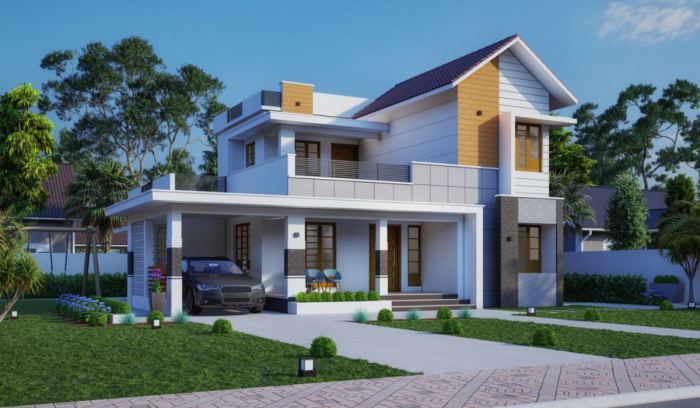
Source: housing.com
Landscaping and outdoor features are integral to completing the modern home aesthetic. They not only enhance the visual appeal but also extend the living space, creating a seamless transition between indoors and outdoors. Careful consideration of plant choices, hardscaping materials, and lighting design is crucial for achieving a cohesive and inviting exterior.The successful integration of landscaping and outdoor living spaces relies on a harmonious blend of design principles.
Modern home exterior design ideas often focus on clean lines and a cohesive aesthetic. However, even with a minimalist exterior, you can inject personality with seasonal touches, such as incorporating festive DIY projects. For inspiration on crafting charming decorations, check out this guide on DIY Easter home decor for some delightful ideas. Returning to the home’s exterior, remember that thoughtful landscaping and lighting can further enhance the overall design.
Minimalism, a core tenet of modern design, translates to clean lines, uncluttered spaces, and a focus on quality over quantity. This translates to carefully selected plants and materials, creating a sense of calm and sophistication. The relationship between the house and the landscape should feel natural and intentional, with the outdoor spaces acting as an extension of the home’s interior design philosophy.
Key Landscaping Elements for Modern Homes
Minimalist gardens, characterized by their clean lines and strategic use of plants, are a hallmark of modern landscaping. These gardens often feature a limited palette of plants, emphasizing texture and form over a profusion of color. Water features, such as sleek reflecting pools or minimalist fountains, add a dynamic element and create a sense of tranquility. The gentle sound of water complements the overall peaceful atmosphere.
Strategic outdoor lighting is essential; it not only illuminates pathways and features but also enhances the architectural details of the home, creating a welcoming ambiance after dark.
Seamless Integration of Outdoor Living Spaces, Modern home exterior design ideas
Patios and decks seamlessly integrated into the home’s design extend the living area outdoors. Materials used for these spaces should complement the home’s exterior materials. For instance, a home clad in concrete might feature a concrete patio, while a home with wood siding might utilize a wooden deck. The transition between indoors and outdoors should be smooth and unobtrusive, perhaps through the use of large sliding glass doors or expansive windows that blur the lines between interior and exterior spaces.
Modern home exterior design often focuses on clean lines and minimalist aesthetics, creating a striking first impression. However, the principles of thoughtful design extend beyond the facade; consider the impact of interior spaces, such as the romantic ambiance you can create with ideas found on this helpful resource for Valentine’s romantic room ideas. Ultimately, a cohesive design approach, from the curb appeal to the intimate details within, contributes to a truly satisfying home.
Careful consideration of furniture placement and the overall layout of the outdoor space ensures a comfortable and functional extension of the living area.
Modern Home Exterior Design: A Case Study
Imagine a modern home with clean lines and a neutral color palette. The hardscaping features a concrete patio, seamlessly extending from the home’s entrance. This patio is bordered by a low, linear retaining wall made of the same concrete, creating a defined space. Softscaping elements include a minimalist garden featuring drought-tolerant grasses such as
- Stipa tenuissima* (Mexican Feather Grass) and
- Carex testacea* (Bronze Carex), planted in strategic groupings to create texture and visual interest. These grasses are complemented by a few strategically placed succulents, such as
- Agave americana* (Century Plant) for bold architectural forms, creating a low-maintenance, modern aesthetic. The overall effect is one of understated elegance and tranquility.
Lighting Design for Modern Home Exteriors
Lighting plays a crucial role in highlighting architectural features and creating a welcoming atmosphere. Proper lighting can transform the home’s exterior at night.
For instance, uplighting can dramatically showcase the home’s architectural details, such as columns or overhangs. Recessed lighting in pathways provides both safety and ambiance, while strategically placed spotlights can highlight specific plants or water features. Warm-toned lighting creates a welcoming and inviting atmosphere, while cooler tones can add a more modern and sophisticated feel. A layered lighting approach, combining ambient, task, and accent lighting, creates a dynamic and engaging exterior space.
Consider using LED lighting throughout, not only for energy efficiency but also for its long lifespan and the ability to easily adjust color temperature and brightness. Low-voltage landscape lighting is a safe and effective way to illuminate pathways and garden features, minimizing glare and maximizing visual impact.
Windows and Doors in Modern Design
Windows and doors are far more than mere openings in a modern home’s exterior; they are integral design elements that significantly impact both the aesthetic appeal and the functionality of the structure. Their strategic placement, material selection, and style contribute to the overall modern feel, influencing natural light penetration, thermal performance, and the connection between indoor and outdoor living spaces.The choice of windows and doors is a critical decision in modern home design, affecting both the visual impact and the energy efficiency of the building.
Careful consideration of materials, styles, and placement is crucial for achieving a cohesive and functional design.
Window and Door Material Comparison
Aluminum, wood, and fiberglass are popular choices for modern home exteriors, each offering a unique blend of aesthetic appeal and performance characteristics. Aluminum frames are known for their sleek, minimalist aesthetic, durability, and low maintenance. However, they can be less energy-efficient than other options unless specifically designed with thermal breaks. Wood frames offer a classic, warm aesthetic, excellent insulation properties, and a high degree of customization.
However, they require more maintenance and are susceptible to rot and insect damage if not properly treated. Fiberglass frames combine the durability of aluminum with the insulating properties of wood, offering a low-maintenance, energy-efficient solution with a customizable aesthetic that can mimic wood grain.
Modern Home Exterior Design Featuring Large Windows and Sliding Glass Doors
Imagine a two-story modern home with a clean, linear façade. The ground floor features expansive sliding glass doors that seamlessly integrate the living area with a spacious patio and garden. These doors, made of sleek, dark-bronze anodized aluminum with slim frames, maximize natural light and create a fluid transition between indoors and outdoors. On the second floor, large, fixed, floor-to-ceiling windows, framed in white powder-coated aluminum, dominate the exterior wall, offering stunning views and filling the interior with abundant natural light.
These windows are strategically positioned to take advantage of the southern exposure for passive solar heating. A smaller, operable window is incorporated near the ceiling for ventilation. The contrast between the dark bronze and the white aluminum creates a visually interesting interplay of textures and colors, highlighting the home’s architectural lines.
Modern Window and Door Styles and Suitability
The selection of window and door styles is crucial for achieving the desired aesthetic for a modern home exterior.
Several factors influence the choice of style, including the overall architectural style of the home, the desired level of natural light, and the need for privacy and security. Here are some examples:
- Minimalist Windows and Doors: Characterized by slim frames and clean lines, these are ideal for homes with a contemporary, minimalist aesthetic. They are often made of aluminum or fiberglass.
- Large Format Sliding Doors: Perfect for maximizing indoor-outdoor flow, these are commonly used in modern homes with open-plan living spaces. Materials can vary, from aluminum to wood.
- Casement Windows: These outward-swinging windows are energy-efficient and provide excellent ventilation. They suit both minimalist and more traditional modern styles.
- Fixed Windows: Often used for showcasing views, these windows are non-operable but maximize natural light. They are frequently seen in large format applications.
- Pivot Windows: These uniquely designed windows rotate around a central pivot point, offering excellent ventilation and a distinctive modern look. They are often made of aluminum or steel.
Last Point
Designing a modern home exterior involves a careful consideration of numerous factors, from the selection of materials and colors to the integration of landscaping and outdoor living spaces. By understanding the key principles and exploring the various design options available, you can create a home exterior that reflects your personal style while enhancing the overall curb appeal and functionality of your property.
The journey to crafting a truly unique and modern home exterior is a rewarding one, offering a canvas for creativity and the opportunity to express your individual aesthetic.
Helpful Answers
What are some emerging trends in modern home exterior design?
Biophilic design (incorporating natural elements), smart home technology integration (automated lighting and security), and the use of recycled and reclaimed materials are currently gaining popularity.
How can I make my modern home exterior more energy-efficient?
Choose energy-efficient windows and doors, consider high-performance insulation, and opt for materials with high thermal mass to reduce energy consumption.
What is the average cost of a modern home exterior renovation?
The cost varies greatly depending on the scope of the project, materials chosen, and labor costs. It’s best to obtain multiple quotes from contractors.
How do I choose the right contractor for my modern home exterior project?
Check references, verify licensing and insurance, and review their portfolio to ensure they have experience with modern design styles. Obtain detailed quotes and compare.
How important is proper maintenance for a modern home exterior?
Regular maintenance is crucial to prolong the lifespan of your exterior and prevent costly repairs. This includes cleaning, inspecting for damage, and addressing issues promptly.

